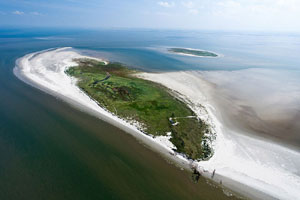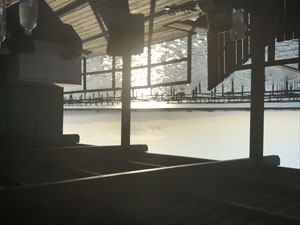Back in the nineteen nineties I spent a week on a slowly disappearing island off the coast of Netherland. We were five volunteers and two steady hands from the national coastal defence agency. Our job was to plant willow shoots in long rows, hoping they would catch enough of the past flying sand to start a process of dune forming which might lead to regeneration of the island vegetation. We were doing this because the coastal defence agency had decided it wanted to protect the island against slowly sliding into the sea.
Off the northern coast of Netherland lie five populated islands in a row, interspersed with a shattering of smaller islets where only animals lives. The sea between the mainland and the islands is very shallow and recognised as a wetland of great environmental importance, not in the least because migrating birds tend to flock here before flying south in autumn. Other species, such as seagulls, prefer using the islets as breeding ground. On their northern side, the islands, which are popular holiday destinations, possess rows of dunes, some easily reaching twenty metres, which form a strong defence wall against storms coming in from open sea. On the south side they are farmland slowly converting into mud where the dunes are fading in the distance, then mud becoming sea. Due to the prevailing wind and sea currents, the islands are slowly crumbling on their western side while depositing sediments on their eastern sides. As a result, the islands seem to slowly walk into an easterly direction. This can be verified by resorting to nineteenth century maps. The differences with today are quite remarkable.
Since the middle of the twentieth century the populated islands are well-protected against this natural process with the help of breakwaters, while the islets were left to their own devices, some growing, some slowly disappearing. The exception had always been the last in the row, the one we were staying at. This island had once held a tiny community of fishermen and farmers, but when it started moving ever faster towards much deeper waters round 1900 and its foundations began flushing into the sea's endless stream, they were forced to leave, with only the agency's custodian and his family remaining until they too left, I believe around 1970. While it had been declining inexorably for more than a century, society felt a need to keep the island safe from extinction and if possible connect it with its little brother to the west, now quickly becoming the big one and showing an uncanny likeness to its predecessor back when, though not populated. The latter idea never materialised, because the sea won't allow for it. Every island grows between two rivers and between two islands there is always a river, however small, it's the law of the wetland. One would have to build a dike to overcome a stream and that was never in the plans.
What was the plan was to try and divert the island's route into the abyss southward towards perhaps not safety but surely longevity. So we set out in a jeep and started digging and planting on the end of the great sand deck that stretched South of that miserable heap of dunes where few animals lived because it hadn't been able to maintain its marsh, a sweet water fountain of life and vegetation that all islands here possess, and had subsequently lost its defence function. We lived in two stone barracks with some wood glass annexes to contemplate rain and shine. We woke up in the dark and worked until sunset, a lot of digging for some of us, there was one woman on our team and we offered her to be our planter, by far the lightest task, she accepted the afternoons but dug along all morning with the rest, it was March and the weather surprisingly mild. We ate enormous portions and we sweated a lot, but it was great fun, being on your own island. The hands gave us an afternoon off to explore the seaside and have a look at the seal colony enjoying the sunshine. At night we played board games (no TV) and drank a bit too much. Sea air makes voracious. We felt proud to be part of the tribe of volunteers who kept the island going, even if it would be a one-off for my mate and me. Just when the weather started changing we sailed back to the mainland to resume our positions in society, mine concerning surviving in copy writing.
Some ten years ago I read in a Dutch newspaper that the coastal defence agency had decided to let Rottumeroog (oog meaning island) slip in the sea. Their efforts had not paid off, the forces of nature were prevailing over well-meaning fools with shovels. The aim was now to concentrate all efforts in saving the next up islet. If you are looking up my story on maps, do not forget to turn on photo and see the amazing arteries and veins of this living thing that is the sea.
And then this. Last September we were in the Delta d'Ebre to celebrate the end of summer with a group of friends. Our host, who is a water manager for the delta force, took us over the smallest roads possible so that we got to see the most beautiful, intimate places in this vast stretch of flat land that so much reminded me of home. Tiny white houses with red roofs, ditches full of water on either side of the road, flowers growing abundantly by the waterside, groups of poplar trees whose leaves were noisily rustling in the mild breeze, it all looked remarkably like the oldest culture landscapes one can find north of Amsterdam. The delta is made by its river and its soil is immediately sweet. The Dutch isles were created further out in sea, where the sediment pushing rivers had always picked up some salty stuff, and whatever came in from the North was much more aggressive than the Mediterranean most days of the year. It makes the delta look more defined. In fact, it sometimes looks like a monument to a nineteenth century development project. But it's gorgeous, it's your own Piet Mondrian.
High point of our day was a visit to a musclera, a rectangle of vertical poles in the water with nets between them, used by fishermen to grow muscles and oysters. The one we went to by boat was out of order and the build-up work place (mending nets and stuff) turned into a restaurant. We sat in the sun, plunged ourselves into the still warm sea, sang along with guitar music and had the best paella ever. All that was missing was a beer sponsor. Already dark, we sailed back and then had to find our way home over the unlit roads. We all promised to do it again the following year, but we hadn't counted with tropical storm Gloria which recently washed away our musclera and many others as well, which plunged an enormous mass of water on tender rice fields, both rain and sea, and ravaged everything which wasn't hard build-up. It must have been a deluge. Nevertheless, the guy from the defence committee sounded comfortingly assured they would recreate the land in not too much time, though lasting damage was done. I hear voices suggesting letting nature have her way, if anything a practical excuse to tap off more water upstream. But the delta is also place to all types of waterbirds, most of them of the photogenic kind. They wouldn't have an alternative nearby to go to if it went the way of Rottumeroog.

 Muscleras to the north of the delta
Muscleras to the north of the delta